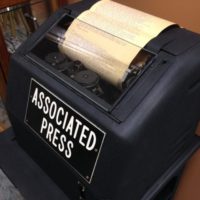 In 1972, radio station KBOA had a little closet in the newsroom that housed two teletype machines. One for the Associated Press and one for the National Weather Service. These typewriter-like printers spewed out line after line of news, sports, weather… everything a radio station might ever want to pass on to its audience. They were loud and smelly and mechanical and the ground through box after box of paper and ribbons. I remember a tractor trailer pulling up to the station every few months to drop off dozens of boxes of each. It was –for all practical purposes– the radio station’s only source for news outside the local community. If someone forgot to feed the beast a new box of paper… or the paper jammed overnight… or the printer ribbon broke… no news. And if the damned thing just broke, you were probably miles from a technician that knew how to fix it.
In 1972, radio station KBOA had a little closet in the newsroom that housed two teletype machines. One for the Associated Press and one for the National Weather Service. These typewriter-like printers spewed out line after line of news, sports, weather… everything a radio station might ever want to pass on to its audience. They were loud and smelly and mechanical and the ground through box after box of paper and ribbons. I remember a tractor trailer pulling up to the station every few months to drop off dozens of boxes of each. It was –for all practical purposes– the radio station’s only source for news outside the local community. If someone forgot to feed the beast a new box of paper… or the paper jammed overnight… or the printer ribbon broke… no news. And if the damned thing just broke, you were probably miles from a technician that knew how to fix it.
I was reminded of those primitive days by a visit from old friend David Gerstmann, founder of WireReady. I met David at an NAB meeting in Boston back in 1991 or ’92. David had just graduated from Tufts University and was exhibiting at the show. He had written an inexpensive software program that could run on the personal computers that were coming into use. Instead of grinding through all of that paper and ribbon, his software could capture and store the information and you just printed out the stories you wanted. Not just from one wire service, but from as many as you had. An amazing idea at the time.
WireReady could also do some word processing tricks that radio news guys found handy. It was affordable, easy to use, ran on the piece-of-shit computer that trickled down to the newsroom and David gave great customer support. He sold a boat-load of WireReady systems and –over the years– introduced new features (networking, digital audio editing, etc).
For a long time, Associated Press and United Press International (UPI) were pretty much the the only sources for world and national news. Not technically a monopoly but they had broadcasters by the balls and they squeezed hard and long. It was a tightly controlled information pipeline but –thanks to the Internet– those days are gone forever. RIP.
Disclosure: The company I work for operates a sort of “poor man’s wire service” (sorry, David) called Learfield Data. It exists today, in part, because broadcasters wanted alternatives to the Big Wire Services of yore.
